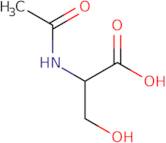N-Acetyl-D-serine
CAS: 152612-69-6
Ref. 3D-CGA61269
| 10mg | Discontinued | ||
| 25mg | Discontinued | ||
| 50mg | Discontinued | ||
| 100mg | Discontinued | ||
| 250mg | Discontinued | ||
| 500mg | Discontinued | ||
| 1000mg | Discontinued | ||
| 5000mg | Discontinued |
Product Information
- (2R)-2-Acetamido-3-hydroxypropanoic acid
- (R)-(+)-2-(N-Acetylamino)-3-hydroxypropanoic acid
- <span class="text-smallcaps">D</span>-Serine, N-acetyl-
- Acetyl-D-serine
- D-serine, N-acetyl-
- N-Acetyl-<span class="text-smallcaps">D</span>-serine
N-Acetyl-D-serine is a methyl ester that is a cofactor for the enzyme serine acetyltransferase. It can be synthesized by reacting D-serine with acetic anhydride in the presence of pyridine and triethylamine. N-Acetyl-D-serine has been shown to have a strong affinity for the active site of serine acetyltransferase, which may be attributed to its ability to form hydrogen bonds with the protein's amino acid side chains. This high affinity can lead to increased reaction yield, as well as specificity for neutral or acidic substrates. The acetylation of D-serine produces N-acetyl-D-serine and pyruvic acid, which are both products of deamination reactions catalyzed by ochrobactrum sp., a bacterial species that thrives in acidic environments. NAC has also been shown to inhibit Lacosamide, an antiep





